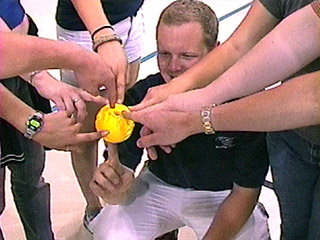Activity 23: Touch the Ball



Touch the Ball Activity
Activity Plan
Group Size: 10 - 20
Time: 3 - 10 minutes
Mental Intensity: 1
Physical Intensity: 1
Space: Minimum
Objectives
- Brainstorm and share creative strategies to touch the ball at the same time
- Act out the different ideas discussed by the group
- Discuss the experience and feelings
Character Focus
Respecting Others
Preparation
Time: None
Materials:
1 Toobeez ball
1 envelope
chart paper (optional)
Setup:
- Place the Risk Taking Note into an envelope.
- Select a Toobeez ball for the group to use.
The Challenge
As a group, everyone must touch the ball at the same time.
Safety Reminders!
Appropriate caution is important to conduct these activities in a safe manner. Be sure to review these reminders prior to beginning the activity, and if necessary, share reminders with the group during the activity.
- Follow general safety procedures
Helpful hints
- This is a great introductory level group problem-solving activity to do at the beginning of a program
- This activity requires people to be close physically, yet prohibits touching
- This is a great activity to lead with large groups (200+)
Activity Instructions
- Circle up the group. Distribute or display the appropriate “Risk Taking Note” for the activity. Have one participant read it aloud twice. Provide a few moments for the participants to think about the message:
“The more you believe in your chosen goal and the possibility of attaining it, the more certain you will be to do so.” - Shakti Gawain - Share the following storyline with group.
This ball will take you anywhere you want to go, but in order for it to work, you must all touch it at the same time. - Read aloud the following Activity Challenge Box to the group.
Challenge: As a group, everyone must touch the ball at the same time. Follow the guidelines below:- No touching anyone or anything else (includes hair and clothing)
- Find a way for everyone to touch the ball at the same time
- If any guidelines are broken, the group must begin again
- Before the participants attempt an activity challenge, have the group work through the following six steps:
- Circle up
- Know and understand the challenge and the guidelines
- Brainstorm
- Make a plan
- Do the plan
- Evaluate results and adjust as necessary
- If participants get stuck, have the students circle up again. Here are some suggested questions to help guide the group back on track*:
- What is working?
- What ideas have you not tried yet that someone suggested?
- If your group is still struggling OR if you feel your group would benefit from an additional challenge, present a variation provided on the next page.
- After the activity, move to the debriefing questions for discussion.
Problem Solving Sequence:
Activity Variations
- Increase the challenge.
After completing the basic challenge outlined above, add these rules: one person in the group must touch with their nose, another with their elbow, another with their knee, and another with the tip of their shoe (which must stay on their foot) and then give the group two minutes to solve this. - Leading with a large group.
Start off by supplying the group with lots of balls (about one ball per eight people). Tell the group that everyone must be touching a ball at the end of 30 seconds without touching anything else. Once everyone has succeeded (this is easy with so many balls), tell the group there has been a “reduction in funding” and they will have to do the same with less. This gives you the reason to take a couple of the balls. Now give the group 30 seconds to find a spot and touch a ball. Once they succeed, remove a few more balls and repeat this process.
Debriefing the Activity
Use these debriefing questions as a guide for your discussion. Select the questions you feel will best benefit your group. It is not mandatory to cover every question. If possible, record the group’s responses on flip chart paper so all comments are displayed. Make sure to let everyone share their ideas, and remind participants that everyone’s opinions and feelings are important!
Base questions for debriefing:
- What did you just do together?
- What does the ball represent?
- How did you feel while you did the activity?
- What was one of the challenges of doing this activity?
- What did the group have to do or believe to be successful?
If the group was unable to complete the task in the given time:
- Since you were not able to solve the problem, does it mean your group is a failure? (Push the group to respond with more than a “yes” or “no” and to instead point out and discuss what they learned.)
- What changes would you make in how you communicated?
Additional questions: Choose which ones are the most appropriate:
- How can a group do more with less?
- How do you feel now?
- What advice would you give to another group working on this activity?
- Did you try different ideas? If so, why did you change your approach?
Close on a Positive Note
Sum up the different ideas and feelings that you heard expressed, and restate ideas and learning moments the participants shared. Then, read the Risk Taking Note out loud again, and ask people to discuss what they think this note means. Discuss what they thought it meant at the beginning and what they think it means now.
* (ˆ) Do not provide the participants with answers. Allow them to work together.





